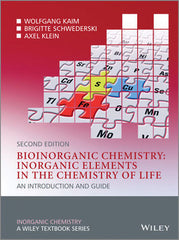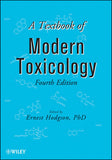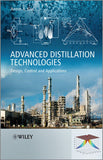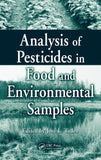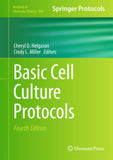Bioinorganic Chemistry -- Inorganic Elements in the Chemistry of Life: An Introduction and Guide, 2nd Edition By Wolfgang Kaim, Brigitte Schwederski, Axel Klein
Bioinorganic Chemistry -- Inorganic Elements in the Chemistry of Life: An Introduction and Guide, 2nd Edition
The field of Bioinorganic Chemistry has grown significantly in recent years; now one of the major sub-disciplines of Inorganic Chemistry, it has also pervaded other areas of the life sciences due to its highly interdisciplinary nature.
Bioinorganic Chemistry: Inorganic Elements in the Chemistry of Life, Second Edition provides a detailed introduction to the role of inorganic elements in biology, taking a systematic element-by-element approach to the topic. The second edition of this classic text has been fully revised and updated to include new structure information, emerging developments in the field, and an increased focus on medical applications of inorganic compounds. New topics have been added including materials aspects of bioinorganic chemistry, elemental cycles, bioorganometallic chemistry, medical imaging and therapeutic advances.
Topics covered include:
- Metals at the center of photosynthesis
- Uptake, transport, and storage of essential elements
- Catalysis through hemoproteins
- Biological functions of molybdenum, tungsten, vanadium and chromium
- Function and transport of alkaline and alkaline earth metal cations
- Biomineralization
- Biological functions of the non-metallic inorganic elements
- Bioinorganic chemistry of toxic metals
- Biochemical behavior of radionuclides and medical imaging using inorganic compounds
- Chemotherapy involving non-essential elements
Preface to the Second Edition xi
Preface to the First Edition xiii
1 Historical Background, Current Relevance and Perspectives 1
References 6
2 Some General Principles 7
2.1 Occurrence and Availability of Inorganic Elements in Organisms 7
Insertion: The Chelate Effect 14
Insertion: “Hard” and “Soft” Coordination Centers 14
2.2 Biological Functions of Inorganic Elements 14
2.3 Biological Ligands for Metal Ions 16
2.3.1 Coordination by Proteins: Comments on Enzymatic Catalysis 17
Insertion: The “Entatic State” in Enzymatic Catalysis 20
2.3.2 Tetrapyrrole Ligands and Other Macrocycles 22
Insertion: Electron Spin States in Transition Metal Ions 28
2.3.3 Nucleobases, Nucleotides and Nucleic Acids (RNA, DNA) as Ligands 31
Insertion: Secondary Bonding 32
2.4 Relevance of Model Compounds 34
References 34
3 Cobalamins, Including Vitamin and Coenzyme B12 37
3.1 History and Structural Characterization 37
Insertion: Bioorganometallics I [1] 38
3.2 General Reactions of Alkylcobalamins 41
3.2.1 One-electron Reduction and Oxidation 41
3.2.2 Co–C Bond Cleavage 42
Insertion: Electron Paramagnetic Resonance I 43
3.3 Enzyme Functions of Cobalamins 45
3.3.1 Adenosylcobalamin (AdoCbl)-dependent Isomerases 45
Insertion: Organic Redox Coenzymes 48
3.3.2 Alkylation Reactions of Methylcobalamin (MeCbl)-dependent Alkyl Transferases 51
3.4 Model Systems and the Enzymatic Activation of the Co–C Bond 52
References 53
4 Metals at the Center of Photosynthesis: Magnesium and Manganese 57
4.1 Volume and Efficiency of Photosynthesis 57
4.2 Primary Processes in Photosynthesis 59
4.2.1 Light Absorption (Energy Acquisition) 59
4.2.2 Exciton Transport (Directed Energy Transfer) 59
4.2.3 Charge Separation and Electron Transport 62
Insertion: Structure Determination by X-ray Diffraction 62
4.3 Manganese-catalyzed Oxidation of Water to O2 68
Insertion: Spin–Spin Coupling 73
References 75
5 The Dioxygen Molecule, O2: Uptake, Transport and Storage of an Inorganic Natural Product 77
5.1 Molecular and Chemical Properties of Dioxygen, O2 77
5.2 Oxygen Transport and Storage through Hemoglobin and Myoglobin 82
5.3 Alternative Oxygen Transport in Some Lower Animals: Hemerythrin and Hemocyanin 92
5.3.1 Magnetism 92
5.3.2 Light Absorption 93
5.3.3 Vibrational Spectroscopy 93
Insertion: Resonance Raman Spectroscopy 93
5.3.4 M¨ossbauer Spectroscopy 94
Insertion: M¨ossbauer Spectroscopy 94
5.3.5 Structure 95
5.4 Conclusion 96
References 96
6 Catalysis through Hemoproteins: Electron Transfer, Oxygen Activation and Metabolism of Inorganic Intermediates 99
6.1 Cytochromes 101
6.2 Cytochrome P-450: Oxygen Transfer from O2 to Nonactivated Substrates 103
6.3 Peroxidases: Detoxification and Utilization of Doubly Reduced Dioxygen 108
6.4 Controlling the Reaction Mechanism of the Oxyheme Group: Generation and Function of Organic Free Radicals 110
6.5 Hemoproteins in the Catalytic Transformation of Partially Reduced Nitrogen and Sulfur Compounds 112
Insertion: Gasotransmitters 113
References 114
7 Iron–Sulfur and Other Non-heme Iron Proteins 117
7.1 Biological Relevance of the Element Combination Iron–Sulfur 117
Insertion: Extremophiles and Bioinorganic Chemistry 118
7.2 Rubredoxins 122
7.3 [2Fe-2S] Centers 122
7.4 Polynuclear Fe/S Clusters: Relevance of the Protein Environment and Catalytic Activity 123
7.5 Model Systems for Fe/S Proteins 128
7.6 Iron-containing Enzymes without Porphyrin or Sulfide Ligands 130
7.6.1 Iron-containing Ribonucleotide Reductase 130
7.6.2 Soluble Methane Monooxygenase 132
7.6.3 Purple Acid Phosphatases (Fe/Fe and Fe/Zn) 133
7.6.4 Mononuclear Non-heme Iron Enzymes 133
References 135
8 Uptake, Transport and Storage of an Essential Element, as Exemplified by Iron 139
Insertion: Metallome 139
8.1 The Problem of Iron Mobilization: Oxidation States, Solubility and Medical Relevance 140
8.2 Siderophores: Iron Uptake by Microorganisms 141
Insertion: Optical Isomerism in Octahedral Complexes 144
8.3 Phytosiderophores: Iron Uptake by Plants 149
8.4 Transport and Storage of Iron 150
8.4.1 Transferrin 152
8.4.2 Ferritin 155
8.4.3 Hemosiderin 159
References 160
9 Nickel-containing Enzymes: The Remarkable Career of a Long-overlooked Biometal 163
9.1 Overview 163
9.2 Urease 164
9.3 Hydrogenases 166
9.4 CO Dehydrogenase = CO Oxidoreductase = Acetyl-CoA Synthase 169
9.5 Methyl-coenzyme M Reductase (Including the F430 Cofactor) 172
Insertion: Natural and Artificial (Industrial) C1 Chemistry 174
Insertion: Bioorganometallics II: The Organometallic Chemistry of Cobalt and Nickel 176
9.6 Superoxide Dismutase 177
9.7 Model Compounds 178
Further Reading 178
References 179
10 Copper-containing Proteins: An Alternative to Biological Iron 183
10.1 Type 1: “Blue” Copper Centers 186
Insertion: Electron Paramagnetic Resonance II 187
10.2 Type 2 and Type 3 Copper Centers in O2-activating Proteins: Oxygen Transport and Oxygenation 191
10.3 Copper Proteins as Oxidases/Reductases 195
10.4 Cytochrome c Oxidase 200
10.5 Cu,Zn- and Other Superoxide Dismutases: Substrate-specific Antioxidants 203
References 207
11 Biological Functions of the “Early” Transition Metals: Molybdenum, Tungsten, Vanadium and Chromium 211
11.1 Oxygen Transfer through Tungsten- and Molybdenum-containing Enzymes 211
11.1.1 Overview 211
11.1.2 Oxotransferase Enzymes Containing the Molybdopterin or Tungstopterin Cofactor 213
Insertion: “Oxidation” 214
11.2 Metalloenzymes in the Biological Nitrogen Cycle: Molybdenum-dependent Nitrogen Fixation 219
11.3 Alternative Nitrogenases 226
11.4 Biological Vanadium Outside of Nitrogenases 229
11.5 Chromium(III) in the Metabolism? 231
References 232
12 Zinc: Structural and Gene-regulatory Functions and the Enzymatic Catalysis of Hydrolysis and Condensation Reactions 235
12.1 Overview 235
12.2 Carboanhydrase 238
12.3 Carboxypeptidase A and Other Hydrolases 243
12.4 Catalysis of Condensation Reactions by Zinc-containing Enzymes 248
12.5 Alcohol Dehydrogenase and Related Enzymes 249
12.6 The “Zinc Finger” and Other Gene-regulatory Zinc Proteins 251
12.7 Insulin, hGH, Metallothionein and DNA Repair Systems as Zinc-containing Proteins 253
References 254
13 Unequally Distributed Electrolytes: Function and Transport of Alkali and Alkaline Earth Metal Cations 257
13.1 Characterization and Biological Roles of K+, Na+, Ca2+ and Mg2+ 257
Insertion: Heteroatom Nuclear Magnetic Resonance 262
13.2 Complexes of Alkali and Alkaline Earth Metal Ions with Macrocycles 264
13.3 Ion Channels 267
13.4 Ion Pumps 270
Further Reading 273
References 273
14 Catalysis and Regulation of Bioenergetic Processes by the Alkaline Earth Metal Ions Mg2+ and Ca2+ 277
14.1 Magnesium: Catalysis of Phosphate Transfer by Divalent Ions 277
14.2 The Ubiquitous Regulatory Role of Ca2+ 283
Further Reading 291
References 291
15 Biomineralization: The Controlled Assembly of “Advanced Materials” in Biology 295
15.1 Overview 295
15.2 Nucleation and Crystal Growth 299
Insertion: Dimensions 300
15.3 Examples of Biominerals 301
15.3.1 Calcium Phosphate in the Bones of Vertebrates and the Global P Cycle 301
Insertion: The Global P Cycle 305
15.3.2 Calcium Carbonate and the Global Inorganic C Cycle 306
Insertion: The Global C Cycle and the Marine Inorganic C Cycle 307
15.3.3 Amorphous Silica 308
15.3.4 Iron Biominerals 309
15.3.5 Strontium and Barium Sulfates 310
15.4 Biomimetic Materials 310
Further Reading 311
References 311
16 Biological Functions of the Nonmetallic Inorganic Elements 315
16.1 Overview 315
16.2 Boron 315
16.3 Silicon 315
16.4 Arsenic and Trivalent Phosphorus 316
16.5 Bromine 317
16.6 Fluorine 317
16.7 Iodine 318
16.8 Selenium 320
References 324
17 The Bioinorganic Chemistry of the Quintessentially Toxic Metals 327
17.1 Overview 327
17.2 Lead 329
17.3 Cadmium 332
17.4 Thallium 334
17.5 Mercury 335
17.6 Aluminum 340
17.7 Beryllium 342
17.8 Chromium and Tungsten 343
17.9 Toxicity of Nanomaterials 344
Further Reading 345
References 345
18 Biochemical Behavior of Radionuclides and Medical Imaging Using Inorganic Compounds 349
18.1 Radiation Risks and Medical Benefits from Natural and Synthetic Radionuclides 349
18.1.1 The Biochemical Impact of Ionizing Radiation from Radioactive Isotopes 349
18.1.2 Natural and Synthetic Radioisotopes 350
18.1.3 Bioinorganic Chemistry of Radionuclides 351
Insertion: Fukushima Daiichi, Chernobyl, Hiroshima and Nuclear Weapons Testing 353
18.1.4 Radiopharmaceuticals 356
18.1.5 Technetium: A “Synthetic Bioinorganic Element” 359
18.1.6 Radiotracers for the Investigation of the Metallome 362
18.2 Medical Imaging Based on Nonradioactive Inorganic Compounds 362
18.2.1 Magnetic Resonance Imaging 362
18.2.2 X-ray Contrast Agents 364
Further Reading 364
References 365
19 Chemotherapy Involving Nonessential Elements 369
19.1 Overview 369
19.2 Platinum Complexes in Cancer Therapy 369
19.2.1 Discovery, Application and Structure–Effect Relationships 369
19.2.2 Cisplatin: Mode of Action 372
19.3 New Anticancer Drugs Based on Transition Metal Complexes 378
19.3.1 Overview and Aims for Drug Development 378
19.3.2 Nonplatinum Anticancer Drugs 379
19.4 Further Inorganic Compounds in (Noncancer) Chemotherapy 383
19.4.1 Gold-containing Drugs Used in the Therapy of Rheumatoid Arthritis 383
19.4.2 Lithium in Psychopharmacologic Drugs 384
19.4.3 Bismuth Compounds against Ulcers 385
19.4.4 Vanadium-containing Insulin Mimetics and V-containing Anti-HIV Drugs 386
19.4.5 Sodium Nitroprusside 386
19.5 Bioorganometallic Chemistry of Nonessential Elements 387
Further Reading 389
References 389
Index
- Systematic element-by-element approach
- Provides full references for further reading
- Includes a glossary of key terms
- Figures are presented in colour to aid comprehension
Related Products
-
A Textbook of Modern Toxicology,...
8,942.00
10,520.00 -
Advanced Distillation Technologi...
13,500.00
15,000.00 -
Analysis of Pesticides in Food a...
2,895.00
13,068.00 -
Analysis of Pesticides in Food a...
10,900.00
12,175.00 -
Basic Cell Culture Protocols 4th...
10,700.00
12,559.00
- Architecture & Construction Management Books
- Biochemistry, Bioengineering and Biotechnology Books
- Books on Analytical Techniques, GC MS, LC, TLC, HPLC, NMR Spectroscopy
- Books on Water and Wastewater Treatment, Analysis Water Treatment Plants
- Chemical Technology, Organic Chemistry, Chemical Synthesis and Chemical Analysis Books
- Cosmetics Science, Cosmetics Formulations, Manufacture and their Analysis Books
- Drugs and Pharma Science Books
- Essential Oils, their Analysis, Natural Products Extraction, Distillation , Isolates Related Books
- Flavor Science, Flavor Analysis, Flavor Creation, Food Flavors Books
- Food Science and Technology, Baking , Food Ingredients , Food Quality , Food Regulations
- Formulations of Perfumes for Agarbatti, Air Freshners, Soaps & Detergents, Fabric Softeners , French style Perfumes, Attars , OUD, Fine Fragrances
- Fragrances, Scents, Attars , Perfumery and Aroma Chemicals Books
- Herbal, Ayurvedic, Medicinal Plants and Aromatic Plants Books
- Law Books
- Major Reference Works (MRWS) Sets - MultiVolume Sets
- Medical Books
- Medical Journals Wolters Kluwer | Medknow India
- NEW ARRIVALS
- Perfumer's Resources
- Special Indian Reprint !



